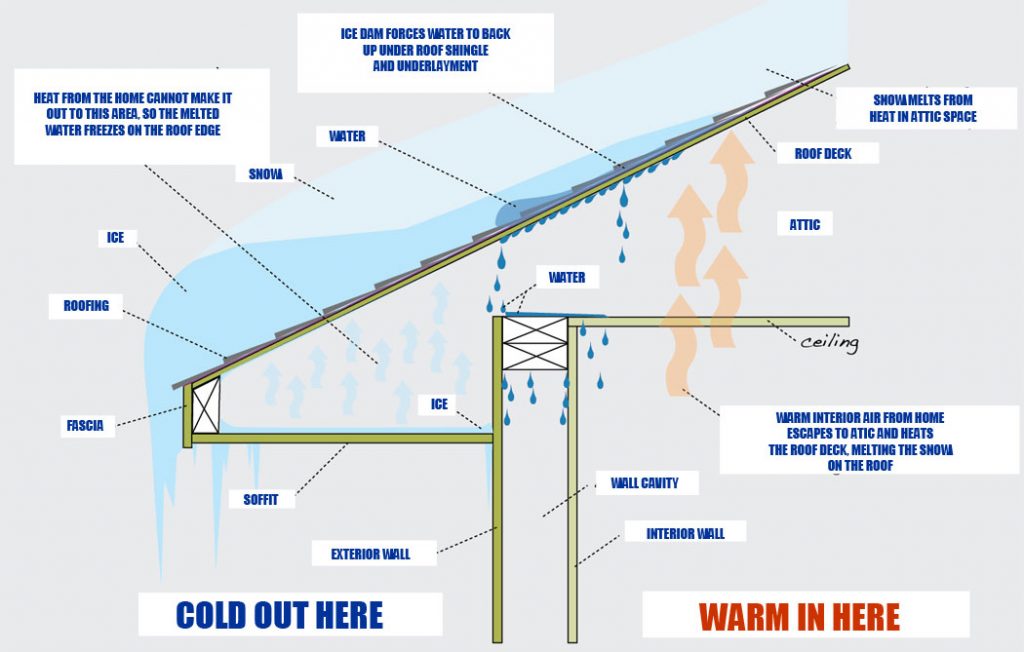 Ice Damming on Sloped Roof Systems
Ice Damming on Sloped Roof Systems
The formation of ice dams on sloped roofs is quite common given the climatic conditions we now experience during our winter season. Ice dams form because of poor attic insulation, poor attic ventilation, significant snowfall or sudden thaw temperatures. These contributing factors result in a roof surface, which is above freezing while the air temperature is below freezing. Under these conditions, the snow in contact with the roof melts, or if it rains, water runs down the roof line and freezes again when the run off is exposed to the cold air or when the run off reaches a cold portion of the roof (i.e. over soffit areas is a prime example). As this process continues, layers of ice are built up and an ice dam is being formed. Now when the runoff water reaches the ice build up, it cannot flow, now we have trapped water. With a shingled roof, there is no positive seal between the shingles, and since sloped roofing is not meant to hold water, water will leak through roof decking and into attic cavity below. The unfortunate part is that even a new roof, with the best installation can be prone to ice damming leakage. In order to prevent ice damming from causing thousands of dollars damaged to the interior of your home; you should take some precautions.
POOR ATTIC INSULATION
Upgrading your attic insulation is a good start; this will start the prevention of warm moist air escaping your home and into attic cavity. This will bring the temperature of the attic cavity close to what the temperature is outside, which is what you are trying to achieve. Be sure not to block the soffit vents on your home with the new insulation.
POOR VENTILATION
Attic ventilation is very important to exhaust any heat that does escape into the attic cavity. It is impossible to totally eliminate the escape of warm moist air into the attic, so it is important to be sure all vents are open and operating properly. If the eave vents are blocked, the flow of air is greatly reduced. This may result in a condensation build up on the underside of roof deck and cause a warm roof deck to start the melt of snow. If the static roof vents are covered by snow, airflow is also greatly reduced. All vents should be kept clear of snow. Turbine vents do move a lot of air, but installing a turbine has mixed blessings. If the problem of warm moist air leakage is not addressed, the turbines will suck more warm moist air into the attic and not help your situation. Also, turbines have a tendency to direct snow that is blowing into your attic cavity.
REMEDIAL MEASURES
Depending on the roof design,(i.e. roof overhang, presence of cathedral ceiling) reducing heat loss and improving ventilation can be expensive. A standard eave protector should be installed on all homes as per building code, however the eave protector will only keep out small amounts of water and not designed to protect against extreme conditions such as ice damming. The installation of ice and water shield membrane is the next line of defense to control water penetration. The membrane is an impervious waterproofing system, starting at the eave and going up the roof a sufficient distance to prevent leakage from water which is backed up by the ice dam. The installation of a heating coil is also often mentioned as a solution. Heating coils can cause more problems than they prevent if not left on during the cold winter months. Turning the heat cable on after formation of ice will compound the problem by supplying lots of melt water back up. Heating cables can also get expensive on the hydro bill.
MAINTENANCE
The immediate problem of water leakage is probably your biggest concern. Professionals should do the removal of snow and ice on your roof. If you think the snow and ice is slippery on the ground, imagine being on sloped surface well above the ground. The snow should be shoveled off and all roof vents cleared. The ice dam formation should have an ice melter, applied to the surface to soften the ice. Once the ice softens, channels should be cut in the ice build up to enhance run off. All valleys and wall flashings should be cleared of ice. The ice should be carefully removed as it softens as not to cause any damage to the roof. Remember damaging your roof when removing an ice dam can happen very easily and never is intentional. The eavestroughs and downpipes should be cleared as well, to prevent water from enetring trough fascia board.